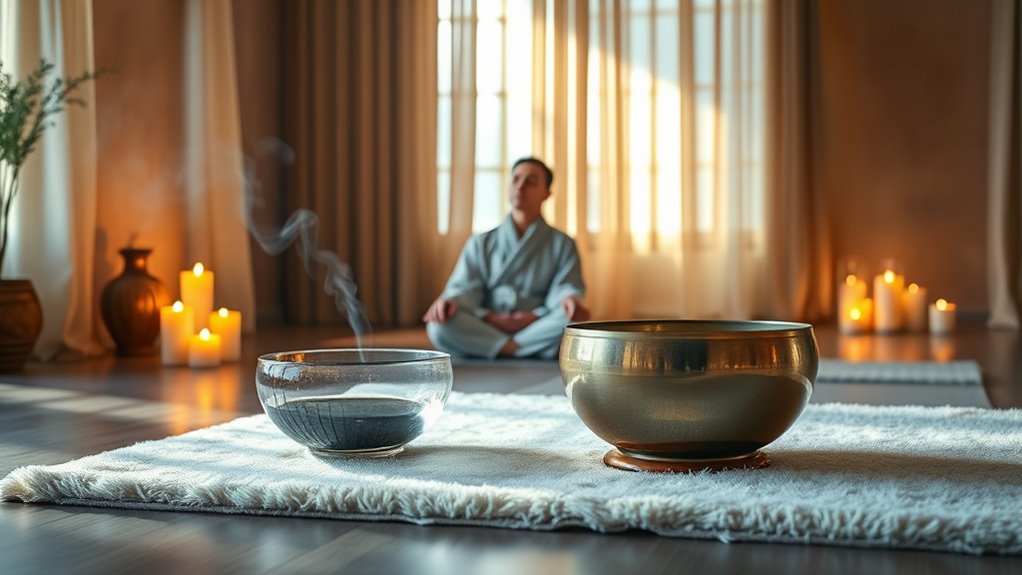To create your own sound bath at home, gather crystal bowls of different sizes and play gentle, steady tones to promote relaxation and healing. Set up a comfortable space with calming lighting, light candles or incense, and establish a consistent practice. Focus on your breath and allow the sounds to guide you into a meditative state. Experiment with different frequencies and techniques—more tips await if you keep exploring.
Key Takeaways
- Select and arrange various crystal bowls to create layered, resonant soundscapes suited for personal healing at home.
- Choose a comfortable, quiet space and set a calming environment with dim lighting, candles, or incense.
- Practice mindfulness techniques like deep breathing and visualization during sound sessions to deepen relaxation.
- Focus on steady, gentle vibrations from bowls, using their tones as anchors for meditation and mindfulness.
- Establish a regular routine to enhance mental clarity, emotional balance, and overall well-being through consistent practice.

Sound baths have become an accessible way to experience deep relaxation and stress relief from the comfort of your home. You don’t need a spa or a studio to enjoy the calming effects of sound therapy. Instead, you can create your own healing space using simple tools like crystal bowls and effective meditation techniques. These tools help you tune into your body’s natural rhythms and promote mental clarity, emotional balance, and physical relaxation.
Create a calming space at home with crystal bowls and meditation for stress relief and deep relaxation.
To start, gather a set of crystal bowls. These bowls are known for their clear, resonant tones that can produce a harmonious soundscape. They come in various sizes and pitches, allowing you to customize your session. When playing them, focus on creating steady, gentle vibrations. The sustained tones help you sink into a meditative state, making it easier to let go of stress and anxiety. You can experiment with different bowls to find the sounds that resonate most deeply with you, or combine them to create a layered, immersive experience.
Next, incorporate meditation techniques that complement the sounds. Begin by finding a comfortable seated or lying position. Close your eyes, take a few deep breaths, and focus on your breath as it naturally flows in and out. As the crystal bowls sound, let the vibrations wash over you. Use the tones as an anchor for your attention, gently bringing your focus back whenever your mind wanders. This practice deepens your mindfulness and enhances the relaxing effects of the sound bath.
You might also try specific meditation techniques like body scanning, where you systematically focus on each part of your body, or visualization, where you imagine a peaceful scene while the sounds play. The goal is to synchronize your breathing and mental state with the frequency of the bowls, creating a meditative rhythm that calms your nervous system. Consistency is key; regular sessions, even just 10-15 minutes, can markedly improve your overall sense of well-being.
Creating a dedicated space for your sound baths can enhance their effectiveness. Dim the lights, light some candles or incense, and set an intention for your session. This environment helps you relax more fully and deepen your connection to the sounds. With practice, you’ll find it easier to access a meditative state, using crystal bowls and meditation techniques as powerful tools for healing and stress relief right at home.
Frequently Asked Questions
Can Sound Baths Replace Professional Therapy or Medical Treatment?
You shouldn’t assume that sound baths can replace clinical therapy or medical treatment. While sound baths promote relaxation and reduce stress, they’re not a substitute for professional healthcare. If you’re dealing with mental health issues or medical conditions, it’s essential to seek guidance from qualified clinicians. Use sound baths as a complementary practice, not a replacement, ensuring you get the appropriate treatment your health needs.
What Safety Precautions Should I Take During a DIY Sound Bath?
Think of your DIY sound bath as a delicate garden that needs careful tending. To keep it safe, you should monitor for harmful sound levels that could damage your ears, much like protecting fragile plants. Be mindful of allergy considerations, especially if you use essential oils or certain materials. Always start with lower volumes, take breaks, and listen to your body—if anything feels uncomfortable, stop immediately. Your safety is the foundation of your healing journey.
Are There Specific Frequencies Best for Different Emotional Issues?
You wonder if specific healing frequencies target emotional issues. Different frequencies are believed to promote emotional balance; for example, 528Hz is popular for healing and positivity, while 396Hz may help release fear and guilt. Personal experience varies, so listen to different healing frequencies to see what resonates. Incorporate these into your DIY sound bath to support emotional healing and foster a calming, balanced state.
How Long Should a Typical Home Sound Bath Last?
A typical home sound bath usually lasts between 20 to 60 minutes, depending on your experience level and goals. Follow duration guidelines to guarantee you don’t overdo it or feel rushed. For beginners, starting with a 20-30 minute session is ideal, gradually increasing as you become more comfortable. Remember, shorter, consistent sessions often provide better relaxation and healing benefits than longer, infrequent ones.
Can Children Participate Safely in Home Sound Bath Sessions?
Children can participate safely in home sound bath sessions if you prioritize child safety and consider their sound sensitivity. Keep sessions short, around 10-15 minutes, and monitor their reactions closely. Use gentle, soothing sounds and avoid loud or overwhelming frequencies. Make certain the environment is comfortable and free from distractions. Always listen to your child’s cues, and if they seem uncomfortable or distressed, stop the session immediately for their well-being.
Conclusion
Now that you know how to create your own sound bath at home, you’re all set to enjoy its calming benefits. Did you know that listening to healing frequencies can reduce stress levels by up to 60%? Incorporating sound baths into your routine can boost your overall well-being and promote relaxation. So, grab your instruments, tune into the frequencies, and embrace the peaceful, healing experience waiting for you right in your own space.









